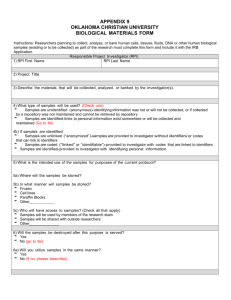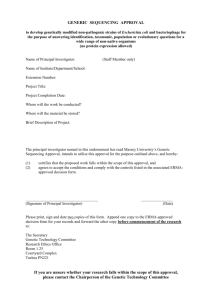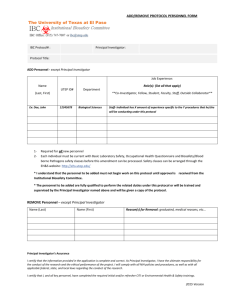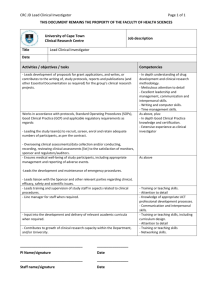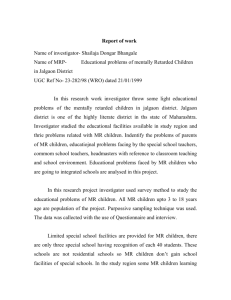Third-Party Access to Existing Data Protocol: Examples
advertisement
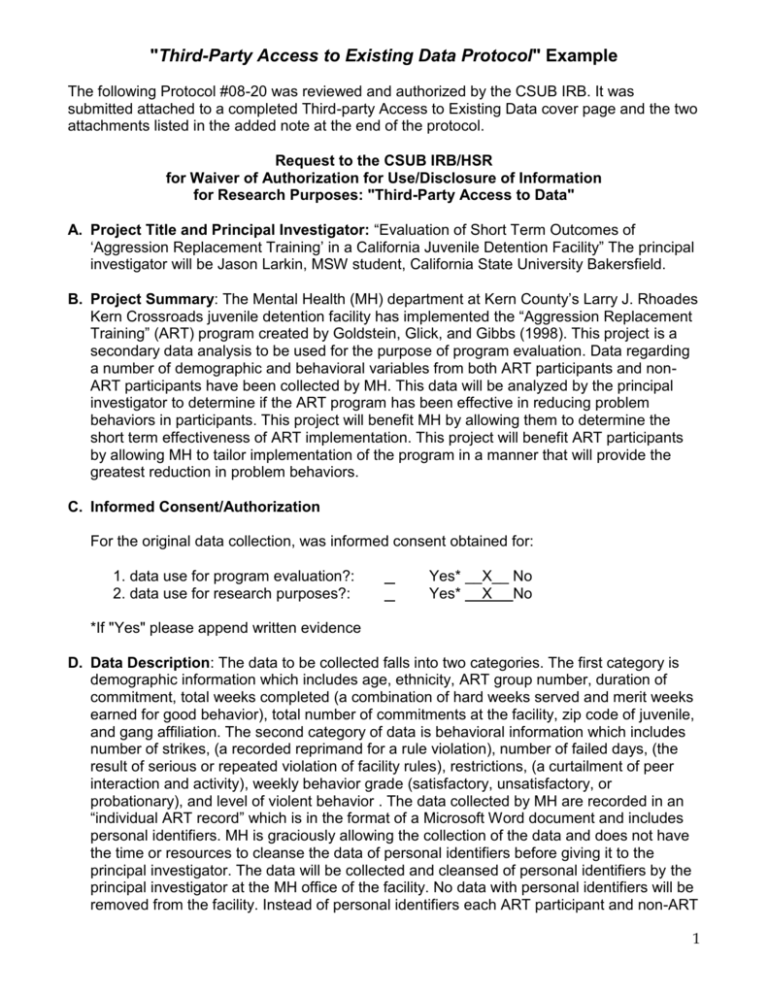
"Third-Party Access to Existing Data Protocol" Example The following Protocol #08-20 was reviewed and authorized by the CSUB IRB. It was submitted attached to a completed Third-party Access to Existing Data cover page and the two attachments listed in the added note at the end of the protocol. Request to the CSUB IRB/HSR for Waiver of Authorization for Use/Disclosure of Information for Research Purposes: "Third-Party Access to Data" A. Project Title and Principal Investigator: “Evaluation of Short Term Outcomes of ‘Aggression Replacement Training’ in a California Juvenile Detention Facility” The principal investigator will be Jason Larkin, MSW student, California State University Bakersfield. B. Project Summary: The Mental Health (MH) department at Kern County’s Larry J. Rhoades Kern Crossroads juvenile detention facility has implemented the “Aggression Replacement Training” (ART) program created by Goldstein, Glick, and Gibbs (1998). This project is a secondary data analysis to be used for the purpose of program evaluation. Data regarding a number of demographic and behavioral variables from both ART participants and nonART participants have been collected by MH. This data will be analyzed by the principal investigator to determine if the ART program has been effective in reducing problem behaviors in participants. This project will benefit MH by allowing them to determine the short term effectiveness of ART implementation. This project will benefit ART participants by allowing MH to tailor implementation of the program in a manner that will provide the greatest reduction in problem behaviors. C. Informed Consent/Authorization For the original data collection, was informed consent obtained for: 1. data use for program evaluation?: 2. data use for research purposes?: Yes* __X__ No Yes* __X__ No *If "Yes" please append written evidence D. Data Description: The data to be collected falls into two categories. The first category is demographic information which includes age, ethnicity, ART group number, duration of commitment, total weeks completed (a combination of hard weeks served and merit weeks earned for good behavior), total number of commitments at the facility, zip code of juvenile, and gang affiliation. The second category of data is behavioral information which includes number of strikes, (a recorded reprimand for a rule violation), number of failed days, (the result of serious or repeated violation of facility rules), restrictions, (a curtailment of peer interaction and activity), weekly behavior grade (satisfactory, unsatisfactory, or probationary), and level of violent behavior . The data collected by MH are recorded in an “individual ART record” which is in the format of a Microsoft Word document and includes personal identifiers. MH is graciously allowing the collection of the data and does not have the time or resources to cleanse the data of personal identifiers before giving it to the principal investigator. The data will be collected and cleansed of personal identifiers by the principal investigator at the MH office of the facility. No data with personal identifiers will be removed from the facility. Instead of personal identifiers each ART participant and non-ART 1 participant whose data will be collected will be assigned a non-identifying number before the data is removed from the facility. When the data is taken from the MH offices at the facility, it will be stored on the hard disk drive of the personal laptop computer of the principal investigator with a backup copy to be kept in a locked file drawer of the project sponsor, Dr. Roseanna McCleary. The computer will be password protected and accessible only by the principal investigator. Only the principal investigator and the project sponsor will have access to this data. The principal investigator has signed a statement of confidentiality that will ensure the personal identifiers cleansed from the data will be kept in the utmost confidence. The data will be analyzed using the Statistical Package for the Social Sciences (SPSS) version 14. Behavioral variables of both ART participants and non-ART participants will be analyzed to determine if there is a statistically significant difference in the type and amount of problem behaviors of ART participants. Demographic and behavioral variables will be analyzed to determine if any correlation exists between variables. E. Justification for Data Access: Since Mental Health Services began using the ART program, they have administered about five or six 10-week cycles of ART. Data regarding each participant in each cycle have been collected by Mental Health and I am seeking access to this data. Allowing access to data collected before I began this project is the only way I will be able to gather sufficient data to analyze for the agency. If I can only collect data that have been gathered after I began the project, then the number of participants’ data that I would conceivably have access to would be much smaller. It is the desire of the agency that I am able to access and analyze all the data they have collected. If I began collecting data immediately with consent, I would have very little or no data to work with, given the time constraints of the project and the 10-week-cyclic nature of the ART program. Consequently, I would be unable to fulfill the desires of the agency concerning this project. F. Justification for Waiver of Authorization: Most of the ART participants for which data have been collected have been released from the facility to the community. Obtaining written authorization from the majority of past ART participants is not feasible because the participants are no longer centrally accessible at the facility and are spread throughout the community. Obtaining these participants’ consent would require much more time than is available for the completion of this project. G. No More Than Minimal Risk The individuals whose information will be used for this project will not be placed at greater than minimal risk by the inclusion of their information. Measures that will ensure this include the statement of confidentiality signed by the principal investigator, lack of personal identifiers in the data removed from the facility, secure storage of the non-identifying data on a password protected private computer, and deletion of the data upon completion of the project in June, 2008. Goldstein, A. P., Glick, B., & Gibbs, J. C. (1998) Aggression replacement training: A comprehensive Intervention for aggressive youth (Rev. ed.) Champaign Illinois: Research Press. [Added Note: The investigator attached to the protocol: [a] a signed “Statement of Confidentiality” promising that he will keep confidential all identifying information and [b] a letter from an agency administrator indicating that the investigator will be granted full access to the ART data.] 2
